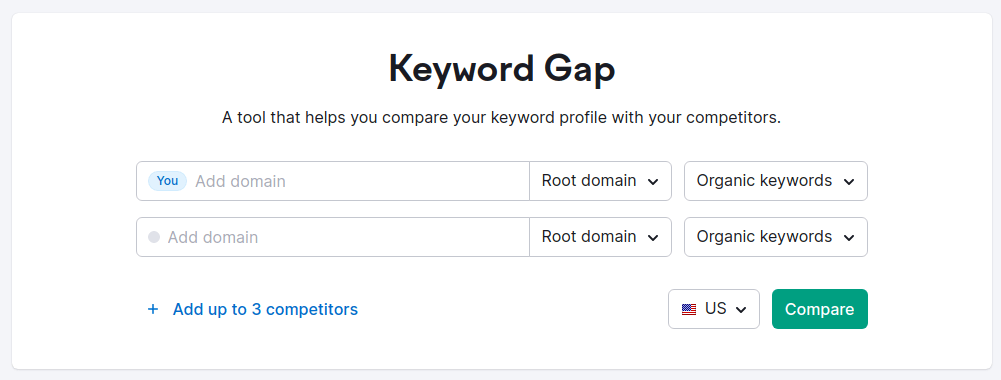Competitor research is a vital part of SEO (Search Engine Optimization) as it allows you to understand the strategies and tactics your competitors are using to achieve success in the search engine results pages (SERPs). By analyzing your competitors, you can identify opportunities and threats, learn from their strengths and weaknesses, and make informed decisions about your own SEO strategy. There are several tools you can choose from.
If you are unfunded and look for free deals you can get a limited free account with SEObility and ProRankTracker. Read on to find out how these tools can help you understand your competitors’ marketing tactics.
Mangools
Slovakia
From $49/mo
SERPstat
Ukrain
From $69/mo
SEObility
Germany
From $50/mo
SEMrush
USA
From $119/mo
ProRankTracker
Israel
From $13,5/mo
- Many companies offer a 20% discount if you can pay for a year. For instance, at Mangools, the discount is almost 40%. Their annual subscription plan cost $358.80 ($29.90 x 12) instead of the $49 regular monthly rate.
Using SEMrush and similar tools can help you gather a lot of information about your competitors’ websites, including:
- Keyword Rankings: These tools can help you track the keywords that your competitors are ranking for, the search volume of those keywords, and their position in search results. This information can be used to identify keyword opportunities and to inform your own content and keyword strategies.
- Backlink Profiles: You can use these tools to analyze your competitors’ backlink profiles, including the quantity and quality of their links, anchor text, and referring domains. This information can help you identify link building opportunities and to evaluate the strength of your competitors’ backlink profiles.
- Organic Search Visibility: These tools can help you track your competitors’ organic search visibility over time, including their average position, the number of clicks and impressions, and the click-through rate. This information can help you understand the competitiveness of your industry and identify areas for improvement in your own SEO strategies.
- Domain Authority: Domain authority is a metric that measures the strength and credibility of a website. You can use these tools to compare the domain authority of your website and your competitors’ websites and understand how this impacts their search engine rankings.
- On-page optimization: These tools can help you analyze your competitors’ on-page optimization, including their title tags, meta descriptions, header tags, and internal linking structure. This information can help you identify areas for improvement in your own on-page optimization and to stay ahead of your competitors in terms of best practices.
- Traffic Sources: You can use these tools to understand the sources of traffic for your competitors’ websites, including organic search, paid search, direct traffic, and referral traffic. This information can help you understand the strategies your competitors are using to drive traffic and inform your own strategies.
- Ad Campaigns: These tools can help you monitor your competitors’ paid advertising efforts, including the keywords they are targeting, the ad copy they are using, and the landing pages they are promoting. This information can help you identify opportunities to outperform your competitors in terms of paid search.
By analyzing this information, you can identify potential areas for improvement on your own website, and come up with strategies for outranking your competitors in search engine results.
In conclusion, competitor research tools like SEMrush, SEObility, SERPstat, Mangools, ProRankTracker are essential tools for any SEO professional or website owner looking to stay ahead of the competition and achieve higher search engine rankings.
For example take a look at the SEMrush Keywork Gap tools
SEMrush Keyword Gap tool can be used to analyze your competitors by comparing their keyword strategies and helping you identify areas for improvement in your own.

Here’s how it works:
- Enter Your Domain and Competitors: Start by entering your domain and up to 5 of your main competitors into the SEMrush Keyword Gap tool.
- View Common and Unique Keywords: The tool will then generate a list of keywords that you and your competitors are ranking for, as well as keywords that only your competitors are ranking for.
- Analyze Competitors’ Keyword Strategies: By analyzing your competitors’ keywords, you can gain insights into their SEO and marketing strategies, including what keywords they are targeting, how well they are ranking for those keywords, and the content they are producing to rank for those keywords.
- Identify Opportunities: The Keyword Gap tool can help you identify opportunities to improve your own keyword strategy by showing you keywords that your competitors are ranking well for, but you are not. By targeting these keywords, you can try to improve your own rankings and close the gap with your competitors.
